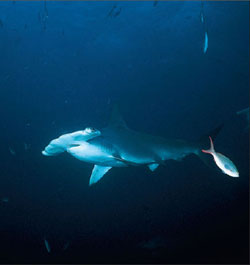Fishes
 |
| Hammerhead shark near the Galápagos Islands. |
In common (and especially older) usage, the term fish has often been used to describe a mixed assortment of waterdwelling animals. We speak of jellyfish, cuttlefish, starfish, crayfish, and shellfish, knowing full well that when we use the word “fish” in such combinations, we are not referring to a true fish. In earlier times, even biologists did not make such a distinction. Sixteenth century natural historians classified seals, whales, amphibians, crocodiles, even hippopotamuses, as well as a host of aquatic invertebrates, as fish. Later biologists were more discriminating, eliminating first the invertebrates and then the amphibians, reptiles, and mammals from the narrowing concept of a fish. Today we recognize a fish as an aquatic vertebrate with gills, limbs, if present, in the form of fins, and usually with a skin covered in scales of dermal origin. Even this modern concept of the term “fish” is used for convenience, not as a taxonomic unit, because fishes do not compose a monophyletic group. The common ancestor of the fishes is also an ancestor to the land vertebrates, which we exclude from the term “fish,” unless we use the term in an exceedingly nontraditional way. Because fishes live in a habitat that is basically alien to humans, people have rarely appreciated the remarkable diversity of these vertebrates. Nevertheless, whether appreciated by humans or not, the world’s fishes have enjoyed an effusive proliferation that has produced an estimated 24,600 living species—more than all other species of vertebrates combined—with adaptations that have fitted them to almost every conceivable aquatic environment. No other animal group threatens their domination of the seas.
The life of a fish is bound to its body form. Their mastery of stream, lake, and ocean is revealed in the many ways that fishes have harmonized their life design to the physical properties of their aquatic surroundings. Suspended in a medium that is 800 times more dense than air, a trout or pike can remain motionless, varying its neutral buoyancy by adding or removing air from the swim bladder. Or it may dart forward or at angles, using its fins as brakes and tilting rudders. With excellent organs for salt and water exchange, fishes can steady and finely tune their body fluid composition in their chosen freshwater or seawater environment. Their gills are the most effective respiratory devices in the animal kingdom for extracting oxygen from a medium that contains less than 1/20 as much oxygen as air. Fishes have excellent olfactory and visual senses and a unique lateral line system, which with its exquisite sensitivity to water currents and vibrations provides a “distance touch” in water. Thus in mastering the physical problems of their element, early fishes evolved a basic body plan and set of physiological strategies that both shaped and constrained the evolution of their descendants.
Position in the Animal Kingdom
The fishes are a vast array of distantly related gill-breathing aquatic vertebrates with fins. Fishes are the most ancient and the most diverse of the monophyletic subphylum Vertebrata within the phylum Chordata, constituting five of the nine living vertebrate classes and onehalf of the approximately 48,000 recognized vertebrate species. Although they are a heterogeneous assemblage, they exhibit phylogenetic continuity within the group and with the tetrapod vertebrates. The jawless fishes, hagfishes and lampreys, are the living forms that resemble most closely the armored ostracoderms that appeared in the Cambrian period of the Paleozoic. The living jawed fishes, cartilaginous and bony fishes, are related phylogenetically to the acanthodians, a group of jawed fishes that were contemporary with the placoderms of the Silurian and Devonian periods of the Paleozoic. The tetrapod vertebrates, the amphibians, reptiles, birds, and mammals, arose from one lineage of bony fishes, the sarcopterygians (lobe-finned fishes). The evolution of fishes paralled the appearance of numerous advances in vertebrate history.
Biological Contributions
- The basic vertebrate body plan was established in the common ancestor of all vertebrates. Foremost was the evolution of cellular bone and the first endoskeleton. The vertebral column replaced the notochord as the main stiffening axis in most adult vertebrates and provided attachment for the skull, many muscles, and the appendages.
- With the brain and spinal cord enclosed and protected within the cranium and vertebral column, the early fishes were the first animals to house the central nervous system separate from the rest of the body. Specialized sense organs for taste, smell, and hearing evolved with a tripartite brain. Other sensory innovations include an inner ear with semicircular canals, an electrosensory system, intricate lateral line sensory systems, and extrinsic eye muscle.
- The development of jaws with teeth permitted predation of large and active foods. This gave rise to a predator-prey arms race that became a major shaping element in vertebrate evolution through the ages.
- The evolution of paired pectoral and pelvic fins supported by shoulder and hip girdles provided greatly improved maneuverability and became the precursors of arms and legs of tetrapod vertebrates.
- Fishes developed the appropriate physiological adaptations that enabled them to invade every conceivable type of aquatic habitat. The origin of lungs and air gulping in early lobefinned fishes permitted limited penetration of semiterrestrial habitats and prepared for the invasion of land with the evolution of tetrapods.




